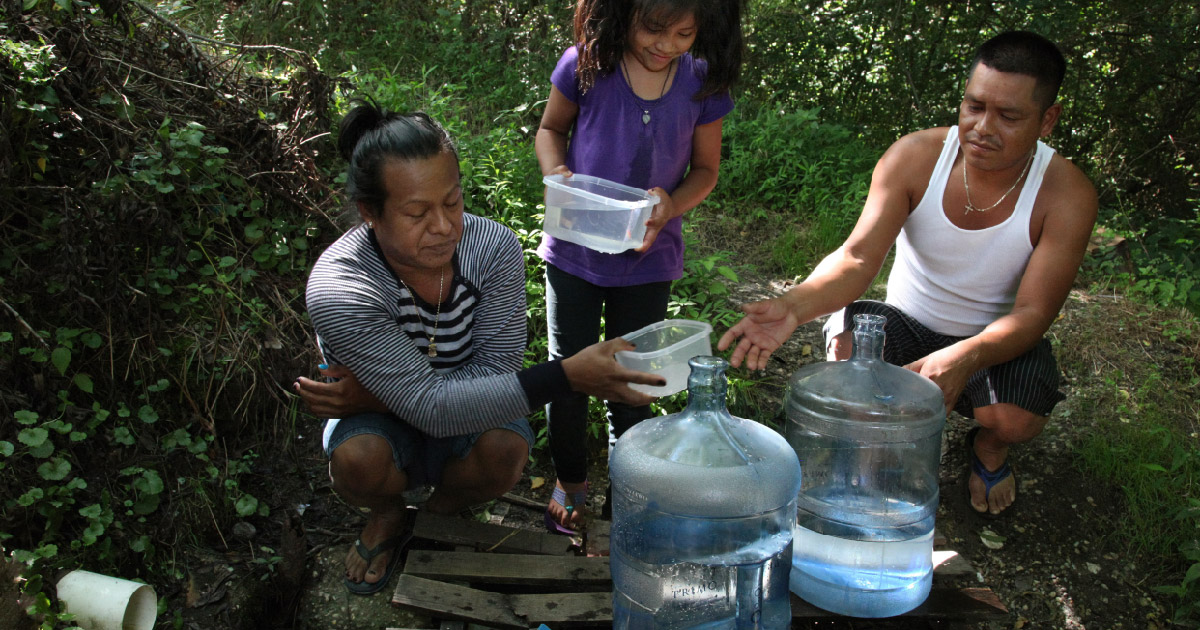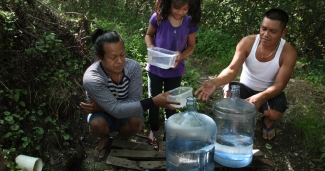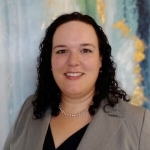World Refugee Day: Lessons from Serving Asylum Seekers

photo: Earl Dotter
[Editor's Note: Today, on World Refugee Day, we commemorate the strength, courage, and perseverance of the millions of refugees around the world, including the thousands who are right now taking the long and perilous journey to our own borders, and the families who have recently reached the border, only to be separated and detained. We at Migrant Clinicians Network have voiced our objection to the current Trump Administration policy to separate children and their parents at the border. (Read our blog post from yesterday, “Children at the Border: Layers of Trauma Compounded by Detention” and our position statement, “Families Seeking Safe Haven Should Not Be Separated.”) The health harm of this policy of separation and detention is unacceptable. As clinicians, we recognize that many asylum seekers currently experiencing trauma may one day be in our own exam rooms.
To honor the unique health needs of asylum seekers, today we reprint “Trauma-Informed Care: Lessons from Serving Asylum Seekers,” written by Kate Sugarman, MD, and published in the Spring issue of Streamline, MCN’s in-print clinical publication. Our Summer issue will be arriving in mailboxes shortly; if you would like to receive the print version of Streamline, please send your name and mailing address to contedu@migrantclinician.org.]
Trauma-Informed Care: Lessons from Serving Asylum Seekers
By Kate Sugarman, MD

A woman came to the exam room with irregular and heavy periods, during which she says she was passing blood clots. She also experienced menstrual cramping. For a typical patient, these symptoms might not have been enough to even go to the doctor. But for a recent immigrant who is seeking asylum and who had been sexually assaulted in her country of origin, these symptoms are traumatic. They also present an opportunity to help her work through her trauma. With just ibuprofen and a few months of birth control, her symptoms lessened, became manageable. After certain screenings, we could also tell her that she did not have any STDs, and she was on the path to healing from her trauma as she began to feel more control over her body and her situation.
Fifteen years ago, I saw my first patient who was an asylum seeker. The patient had been referred to me by chance, but I soon discovered there was enormous need for scar documentation among this population, and I found the work incredibly satisfying. I soon began seeing survivors of torture in the Washington, DC metro area, offering my services as a doctor for free to the clients, survivors from Cameroon, Eritrea, Ethiopia, from other parts of Africa, and from South Asia as well. Almost all had been beaten, tortured, and imprisoned for their political views, their sexual orientation, or other difference, in their home country. Some of them had been detained by the US immigration system as well. All were now seeking asylum, and needed care.
Patients who have experienced trauma — from life-threatening torture in their homeland, to sexual assault during a long migration, to traumatic events within the US’s own immigration system — require a trauma-informed care model. A clinician following such an approach recognizes the widespread impact of trauma on health and identifies the signs and symptoms of trauma, while providing care that adheres to the basic principles of serving people with trauma (See sidebar). As providers, we can reframe the exam room experience, help the patient work toward achievable health goals, and refrain from re-traumatizing the patient. Many of the following tactics are applicable for migrant patients who may have recently arrived at your own clinic, and may be harboring traumatic experiences from their home country or during migration, even if advanced torture isn’t present. Our careful consideration of their unique health needs can lead to better results and stronger trust relationships.
1. Uncover health concerns while giving the patient some control.
When patients arrive in the US, they often have long-ignored medical health concerns, some of which may have already been diagnosed. While every moment in the exam room is already overtaxed, a review of the medical history can help a provider drill down on the best and quickest steps the patient can take with the provider’s support to make health improvements. If a patient arrives in the clinic with stomach pain and dizziness, it would be helpful to already know she suffers from hypertension and hasn’t used any medication since her arrival. It may seem obvious, but backing up a moment to see what we already know can save valuable time in the exam room.
Some common health concerns may be diagnosed for the first time in your clinic. This can be an opportunity to lead not just to quick health turnarounds but also to a strengthening of the patient-provider relationship. Seeing a responsive, knowledgeable, and culturally competent provider, the patient feels the provider understands what they’ve been through — and will be more willing to try a medication for the newly diagnosed diabetes or to begin taking in a new HIV diagnosis and thinking through a treatment plan. Patients recovering from trauma often have experienced prolonged loss of control. I try to allow the patient to be in control as much as possible. I also make sure I’m providing eye contact, warmth, and a kind demeanor. I often learn some greeting in the language of my patients, which goes quite far at putting people at ease.
In my exam room, questions about assault are not asked unless symptoms are suggestive. I ask quietly and with eye contact, “Why are you here today?” I allow them to make the choice of what they want to talk about. I never ask about sexual assault, but I maintain space for patients to bring it up if they feel comfortable. Headaches are often a common ailment, so I may feel driven to ask of there’s a history of head trauma, a common history among asylum seekers. For either newly diagnosed or previously diagnosed concerns, we may be able to make considerable health progress in a short amount of time. Such a health win can mean a great deal to a patient who has struggled for a long time and, in his or her new position as an asylum seeker, feels powerless and stuck in other parts of his or her life. By pinpointing a health problem and establishing a plan together wherein the patient can make measurable progress, the patient can feel more in control and hopeful.
2. Make the basic tests routine at the first visit.
With all new clients, I screen for Hepatitis B and C, HIV, and diabetes, and other conditions as indicated. Most patients like my approach during which we “check for everything,” because they feel well cared for and often find comfort in the results. Some patients are reluctant, claiming they have not engaged in behavior that would result in some of the health concerns for which I am screening. I assure them that I screen all new patients — this is not a special test just for this patient — and often, because it’s billed as a routine new patient check, this satisfies any concerns. Of course, the final say is up to the patient. Among traumatized patients like asylum seekers who have survived torture, I emphasize to patients that they are ultimately in charge of their bodies, and I am there to support their health. This can run contrary to our medical training, but can go a long way in building the trust relationship and in avoiding re-traumatizing the patient. For a patient who rejects an HIV test, I tell them to just tell me when they are ready.
For those who have experienced sexual assault, knowing the results of the tests — positive or negative — can provide some much-needed relief so they can begin to move on. One patient from West Africa came to me, severely depressed and suicidal. The key to moving him toward recovery was his first visit to the doctor. I checked him for everything, with his consent. To his relief, he Trauma-Informed Care: Lessons from Serving Asylum Seekers By Kate Sugarman, MD MCN Streamline 5 was HIV negative. He had a mild case of Hepatitis B that did not require treatment and he did not have liver damage. After we talked about his results, he was able to open up, about being raped, about torture. Immediately, upon getting a better understanding of his health — in fact, getting a better bill of health than he expected — he could begin to envision a path forward to healing.
While I do encourage most basic tests from the beginning, I do not do a pap smear during the first visit. For many women, this can feel too invasive, too foreign, and very traumatizing. I work up to pap smears. I only do a pap smear when a patient tells me she is ready and feels supported enough to do so. I make sure to tell her that she can stop at any time — she remains in charge of the encounter. It often takes many office visits before a patient is ready for the pap smear.
Conversations around contraception can be very difficult as well. Sexual abuse, relationships split by migration, and new relationships add many layers to the conversation. In my practice, I have seen vulnerable patients with precarious housing or work situations who were sexually harassed by a person of power. I try to address such concerns fully, which includes help with preventing unwanted pregnancy.
I remind myself that I cannot solve everything in a 15-minute visit, but I can show patients that the door is open for them. On a future visit, they can bring up contraception, or their back pain, or other concerns. Maybe the questions of sexual assault won’t come up for the first five visits — and that’s okay. I also try to ask questions. Most of my patients are from Africa. I recently had a new patient from India, and I had no idea what the conditions were like in his hometown, what he may have experienced, so I simply asked. Of course, I also make sure that new patients are linked to mental health providers as an essential next step for their care — another way of recognizing that not all can be completed during the primary care visit.
3. Document any physical or emotional scars you uncover.
At the very first visit, it is important to note any scars, wounds, depression, mismanaged medical conditions, or other evidence of torture-related injuries such as limited range of motion of joints and broken or missing teeth, as patients may need this documentation as evidence in the future. It only takes a few moments to make relevant notes on patients’ charts about complaints of headaches that may be related to being beaten, or about the PTSD or other psychological concerns the patient exhibits. During future appointments, or by the time the patient has his or her asylum case hearing, some of this physical evidence may have already faded, so it’s important to do this early on. Such documentation can be important for any new migrant — those coming out of detention, newly arrived immigrants, or migrants who are passing through. It doesn’t have to be extensive — just capture what it looks like that day: does the scar look like a cigarette burn? Was the patient crying?
4. Don't assume anything.
As part of giving the patient greater control over the patient-provider interaction, I try to ask very open-ended questions, allowing the space and time for patients to tell me why they are here. I don’t barrage them with questions. In fact, I avoid even simple questions like, “Do you have a wife? Do you have children?” Such specific questions can be traumatizing for a patient who has left a family behind in a dangerous situation. I do not assume anything about patients. I cannot assume that what they tell their lawyers or their case manager is what they tell me as the provider. One client had visited several doctors, and didn’t want to go back. After a long and open conversation, she revealed that she was raped and she never told any of her previous providers. This reinforced my careful approach to her care, wherein we only moved forward at a pace that she felt comfortable.
5. Long-term trauma-informed care means uncovering and treating the many layers of trauma, stress, and suffering.
Patients arrive with serious trauma from their home countries — but the story of trauma doesn’t stop at the border. New trauma from their time in detention and from encounters with crime in their new US communities are not uncommon. Ongoing stress and serious life events, which can be upsetting and disruptive for all of us, may for a traumatized patient retrigger their symptoms. One patient’s long-term recovery was going well, until she got into a minor car accident. While she didn’t sustain any injuries, the accident brought to the surface the memories of torture that she was previously able to manage. Another patient’s mother died in Africa, and he was unable to be with his family, to grieve together. These type of events can manifest in the primary care office in their bodies — stomach aches, headaches. One man came in with back pain, but when trying to uncover the source, I learned that a family member had recently been abused as retaliation for him fleeing. Primary care is a not stigmatized as compared to mental health specialists’ offices — and consequently many of these issues of trauma are presented in the primary care setting.
Primary care providers can play a tremendous role, not only in providing comprehensive primary care and documenting abuse and torture, but also by advocating for patients’ needs and family. Patients who are seriously ill may be eligible for an expedited asylum hearing. I wrote a letter for a patient suffering severely from brittle diabetes and succeeded in moving up his hearing so he could focus on recovery. Similarly, if a family member of an asylum seeker is in jeopardy, I can write a letter to immigration to move things forward. A five-year-old deaf child of an asylum seeker had no access to services. Consequently, the child had no communication with his family, no special education, no hearing aid. I successfully argued that the family needed to be reunited so the child could get basic needed services to function in the world. A doctor’s note can really make a difference.
There’s also a big role for providers to help those who are detained in the US and denied medical care. I’m currently working on a case of a man with inadequately treated seizures who is in ICE custody. Shockingly, many detainees have serious and unmet health needs, in facilities in our homestates. To me, this is intolerable — and I’m looking forward to working more on this issue and helping more people access the care they need.
Trauma-informed care means providing comprehensive and compassionate care, and many of our patients need this approach — not just asylum-seekers, but many recent immigrants or migrants in our communities.
Read more at SAMHSA’s Trauma-Informed Approach page: https://www.samhsa.gov/nctic/trauma-interventions
Like what you see? Amplify our collective voice with a contribution.
Got some good news to share? Contact us on our social media pages above.
Return to the main blog page or sign up for blog updates here.
- Log in to post comments

